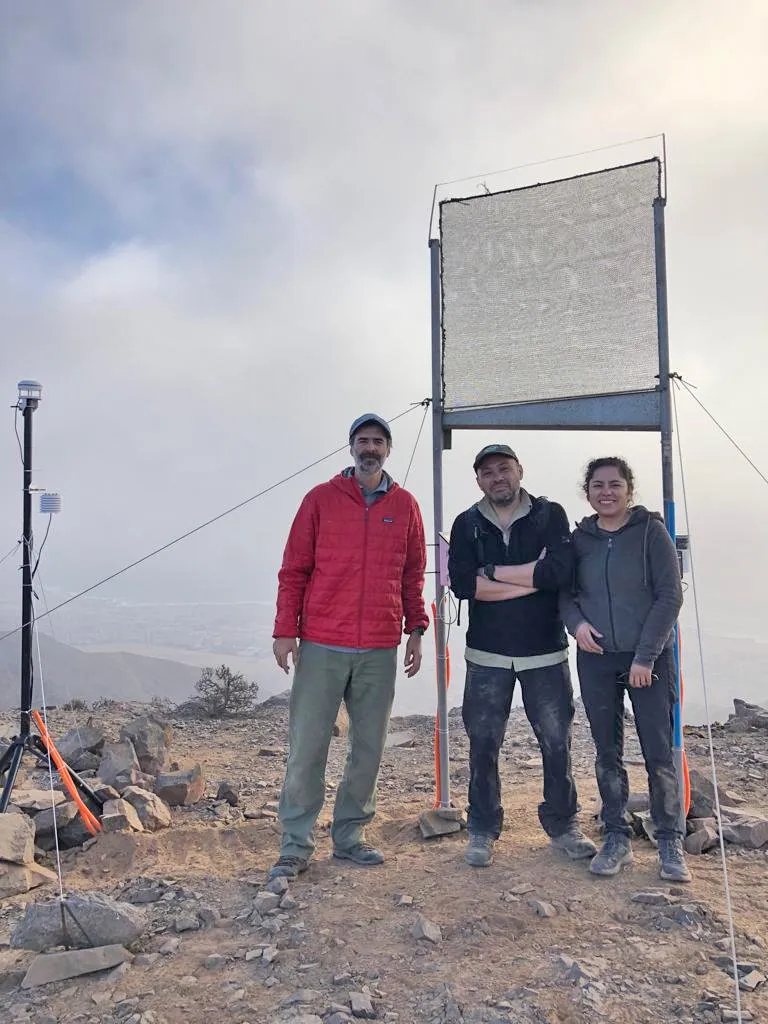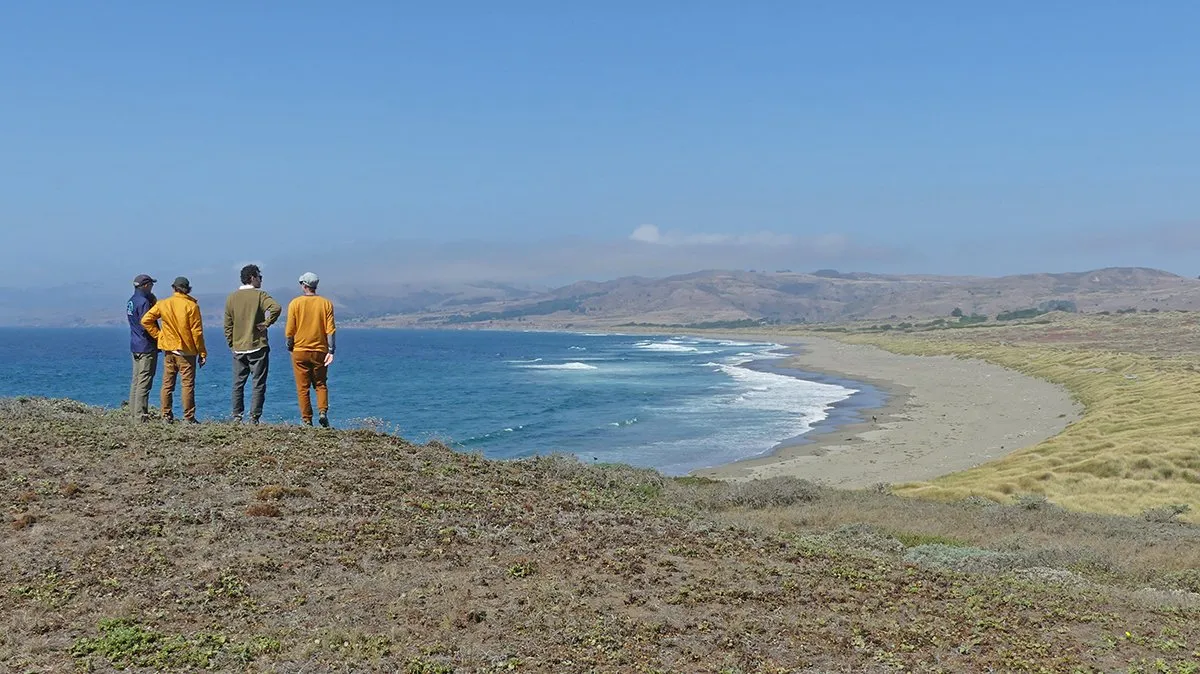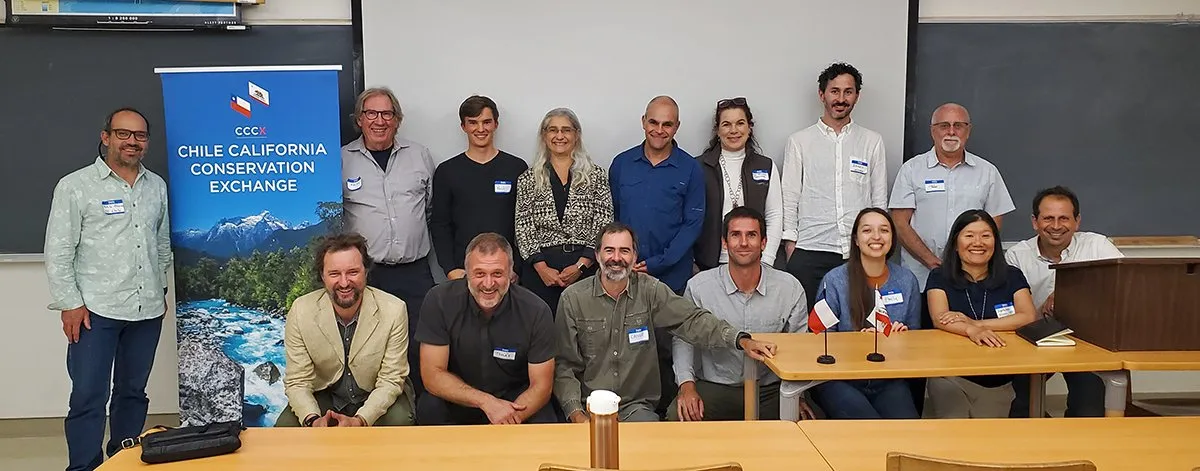Fog binds California and Chile together
By Kathleen Wong, UC Natural Reserve System
The thick fog that cloaks California shorelines over summer has an atmospheric counterpart south of the equator. Marine fog not only drenches coastal sections of the South American nation of Chile, but is so reliable that some communities there use fog for drinking water. And in both areas, coastal fog is needed to support ecosystems such as the lush redwood forests in California and the air plants in Chile’s Atacama Desert.
It should come as no surprise, then that, fog research will be the first product of a sister reserve agreement signed this past spring between the University of California Natural Reserve System and the network of regional centers and field stations (RCER) at the Pontifical Catholic University of Chile (UC Chile). The agreement smoothed the way for four scientists from UC Chile and RCER to tour NRS reserves in September. On the trip, the Chileans met fog researchers from UC and a variety of other institutions; learned about field station management from NRS staff; and planted the seeds of future field course exchange opportunities for students.
The visit also helped cement connections between the two universities. “It’s very important to look for concrete, specific agreements and start making use of these opportunities,” says head of RCER Sergio Guitart Franetovic. “So many agreements like this just sleep in a binder and don’t meet their potential.”


The UC scientists have studied coastal fog for many years. Here, Camilo Del Rio stands by a fog collector near the Atacama Desert city of Antofagasta, which relies on fog for its water supply.
A long history of fog research
The idea for the visit originated with UC Chile geography professor Camilo Del Rio. For more than 20 years, Del Rio and colleagues have studied fog along Chile’s lengthy coastline. The scientists have been measuring contributions from fog water to plants, modeling the ebb and flow of fog with climate, and developing ways to collect fog water to supply human settlements. Their 25 fog research sites range from RCER’s Atacama UC Station—Alto Patache in the north, to its Coastal Marine Research Station—Las Cruces in central Chile.
Fog is a vital part of survival in the Atacama, the world’s driest desert. “In that environment one droplet of water is gold,” Del Rio says. Rainfall there averages less than 1 mm a year. Fog supplies nearly all of the water that supports human and natural communities. Del Rio’s efforts to collect fog water for human consumption soon expanded into studies of fog water contributions to the ecosystem, fog modeling, and the effects that climate change might have on this important source of moisture.
A scientist from California alerted Del Rio to the fog science scene in California. That piqued Del Rio’s interest for a tour of Golden State fog research sites.
“We had very similar research questions. For example, whether climate change will cause more fog or less fog; whether the climate is bringing more water or less water. I thought okay, maybe in California, they’re using with different approaches that we’re not considering? That’s when I said it’s a big opportunity to see what they are doing in California related to fog,” Del Rio says.


Pablo Osses (left) and Camilo Del Rio (gray shirt) visiting Santa Cruz Island Reserve with Norah Reti (blue hat) and US Geological Survey research ecologist Kathryn McEachern.
Time for a road trip
Del Rio was about to start arranging a fog tour of California when he learned about the RCER/NRS agreement. He immediately enlisted RCER head Sergio Guitart Franetovic in the plan. “I said, for sure, I’ll help you. I just started brokering, connecting their interests with what the NRS could offer,” Guitart says.
Additional support for the tour came from the Chile-California Council, which facilitates connections among science, government, and industry in both regions.
Working off advice from NRS contacts, Guitart, Del Rio and fellow UC Chile fog scientists Pablo Osses and Juan Luis Garcia designed a road trip from Los Angeles north to San Francisco. Their jam-packed itinerary included stops at six NRS reserves: Santa Cruz Island, Landels-Hill Big Creek, Fort Ord Natural, Younger Lagoon, Año Nuevo Island, and Bodega Marine. As though these visits weren’t enough, the group added a tour of independent Pepperwood Preserve in Santa Rosa; a meeting with government representatives in Sacramento; meetings with faculty at UC Santa Cruz, and presenting at a roundtable on fog research at UC Berkeley.


As the Chilean scientists traveled across California, the many parallels between the two regions grew ever clearer to them. “We kept saying to each other, Chile is the same as California, but opposite,” says Guitart. Here, the scientists look out at Salmon Creek Beach from Bodega Marine Reserve.
Cross-border commonalities
The potential for trans-hemispheric fog research grew clear from the group’s first stop at the NRS’s Santa Cruz Island Reserve. Del Rio was particularly eager to visit the reserve because it is at a similar latitude to RCER’s coastal marine station in Chile. He marveled at the similarities he witnessed between the two. “It’s amazing, the potential of collaboration that we have on that reserve. The conditions are really similar. We suffer from similar environmental problems, the same kind of precipitation, the kind of invasive species that get into these natural places,” Del Rio says.
During a tour of the island, reserve director Jay Reti described the weather dynamics. “All the fog rolls in the from the west into the valley, and this high point keeps the fog in this little bowl. That’s where you get all the Bishop pine trees. They’re fog adapted,” Reti says. Research now seeks to identify the extent of fog penetration. “It’s going to help us identify refugia for island endemic species in the face of climate change.”
At present, however, fog instruments at NRS reserves like Santa Cruz Island tend to be custom-designed one-offs. This is quite different from the UC Chile fog array. “We’re measuring the same variables with the same sensors, with the same specifications. At the end, we can compare it. That is something that I think we can coordinate and improve for California,” Del Rio says.
Standardizing fog equipment and measurement protocols would enable the two networks to exchange data and conduct joint research. “Having a broader approach to fog in coastal Pacific environments across the Americas is also something that we want to do,” Reti says.
Potential for forecasting
The Chilean scientists have done considerable fog behavior modeling with data from their fog measurement arrays. This experience could inform the development of similar forecasting methods in California. The resulting scenarios could help scientists identify whether fog is waxing or waning in the state. By extension, the models could predict the effects of climate change on fog-dependent ecosystems such as maritime chaparral and coast redwoods.
Joining forces in fog modeling and forecasting will benefit both regions. “California and Chile are arid Mediterranean environments that are very fragile. A small change in the climatic parameters produce a very huge impact in these ecosystems. If you want to generate a conservation strategy to inform people along those coasts, you need to give them relevant and trustable data and information,” Del Rio says.


UC Chile fog scientists Pablo Osses, Camilo Del Rio, and Juan Luis Garcia visiting Año Nuevo Island Reserve with reserve director Patrick Robinson and UCSC Professor Dan Costa.
Knowledge exchange
After stops at Big Creek and Fort Ord Natural reserves, the visitors attended a tour of UC Santa Cruz and met with faculty. Marine biologist Dan Costa and the campus’s Global Engagement Office were instrumental in organizing these visits, plus stops at Younger Lagoon and Año Nuevo Island reserves. The following day found the group at Bodega Marine Reserve, where they received a tour of both the coastal reserve and Bodega Marine Laboratory from UC Davis oceanography professor John Largier.
Despite their long experience studying fog, Del Rio and colleagues also gained a few new tricks from their California counterparts. For example, they learned how environmental toxicologist Peter Weiss used chemistry to track the source of the high levels of mercury in coastal organisms to marine fog. They also encountered a new device that uses lasers to detect fog density.
For his part, Guitart absorbed as much as he could about NRS policies and procedures, in hopes of being able to apply some to RCER. Seeing how the 57-year-old NRS functions, Guitart says, will help his brand-new network, which brings together UC Chile’s existing field stations, to dodge potential pitfalls. Guitart gained insights from experiences such as using NRS’s online Reserve Application Management System (RAMS) to make arrangements to visit reserves; observing the use of radios and posted policies to keep students safe; and discussing the career trajectories of reserve staff. Of particular interest was learning how UC instructors use reserves for undergraduate field instruction, something Guitart hopes to encourage at RCER. To that end, he obtained a copy of the syllabus for the NRS’s California Ecology and Conservation Program.
Guitart says the connections he made on the trip were invaluable. “We had the chance to meet in real life and share a meal and a laugh with the people who make the NRS really work,” Guitart says.


A fog roundtable at UC Berkeley brought together fog researchers from both UC Chile and California as well as representatives from the Chile-California Council.
A fog science summit
The group wrapped up their trip by participating in a fog roundtable at UC Berkeley. The event was hosted by professor Todd Dawson, who studies coast redwoods and their reliance on fog water. Attendees included fog and data experts from the US Geological Survey, Cal State Monterey Bay, Pepperwood Preserve, and several UC campuses, as well as representatives from the Chile-California Council.
The Chilean researchers gave presentations about their fog research program, which has included optimizing the capture of fog water for human use, studies pf paleoclimatic fog inputs to inform archeological finds, fog occurrence sensing and modeling, and the role of fog in local ecosystems as well as vegetation restoration. They described their hopes to build a fog monitoring network along the Pacific coast to monitor climate change impacts on fog in both Chile and California.
In the weeks since the roundtable, participants have agreed to work toward establishing the Chile California Coastal Climate Change Cooperative, dubbed 6C. Making such a network a reality will require not only standardizing equipment but also data capture and storage methods. Both the NRS’s Dendra environmental sensor data portal and the US Geological Survey’s data integration experts would play a central role in data storage and sharing.
“I think it’s amazing that we had the opportunity to connect initially our purposes and finally reach an agreement for collaboration. There are so many points where we could really make use of this written agreement. We just have to put our hands to it and I think a lot of good things will come about,” Guitart says.
Medio: UC Natural Reserve System
